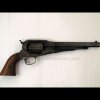Howdy
Here is a photo of an original Remington that was converted to shoot cartridges. Notice how short the front sight is. That is the way they were made.

Here is a photo of my EuroArms Remmie that I bought back in 1975. Notice how tall the front sight is. That is NOT the sight that came with the gun. The original front sight was much shorter, much like you see on the original, antique Remington above. With the original front sight, the gun always shot high. So when I decided to buy a cartridge conversion cylinder for it, the first thing I did was change the front sight. I had a gunsmith mount a standard Uberti front sight on it. The original front sight was dovetailed in, but he had to open up the dovetail to fit the Uberti sight. Once it had its new, taller front sight, but before I bought the cartridge conversion cylinder, I took it to the range to see where it was printing. At reasonably close range, about 10 or 15 yards, with a 44 caliber ball over about 30 grains of FFg it printed right where I wanted it too, pretty much to point of aim. So then I went ahead and bought the conversion cylinder that you see in the gun now.

What load are you using? Too heavy a load could be causing the muzzle to rise before the ball/conical leaves the barrel?
News Flash: The muzzle ALWAYS rises before the ball leaves the barrel. ALWAYS! It does not matter how light the powder charge is, or how light the ball is, the muzzle ALWAYS rises before the ball/conical/bullet leaves the barrel. Boresight a revolver some time and you will see that the front sight pushes the bore lower than the point of aim. That is to compensate for the amount the muzzle will rise as the ball travels the length of the barrel.
So. A heavier load will always cause the muzzle to rise more before the bullet leaves the barrel than a lighter load will. More powder/heavier projectile, the muzzle will rise more. I have never used 777, but it is pretty well known that it is about 15% more energetic than a similar charge of real Black Powder. So one thing you can do right off to lower the point of impact is to lower the powder charge.
I usually shoot 45 Schofield rounds out of my converted Remmie. About 28 grains of FFg under a 200 grain .452 bullet. Since the bullet is heavier than a ball, the recoil is more, and the muzzle rises a bit more than it would if I was shooting a ball. I just hold at 6:00 O'Clock on the target and the bullet goes where I want it to.
I downloaded this photo from the Cabellas website of a target version of the Remington they are selling. Is this what yours looks like? If so, that's a pretty hefty front sight. If your rear sight is cranked all the way down, about the only thing you can do to lower the point of impact is to either lighten your load and/or build up the front sight.

The other thing to bear in mind is that the trajectory of a bullet from a revolver will cross the line of sight at two points. One point will be fairly close to the muzzle, the other point will be out some distance. Exactly where any revolver prints, with any specific load, will also depend on where the target is placed relative to those two points. At the midpoint between those two points, the trajectory will be at its highest.
You might want to try shooting at a couple of different distances to see what is going on. 25 yards is pretty far out to be sighting in a revolver.





